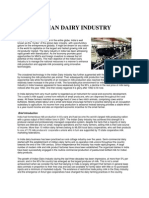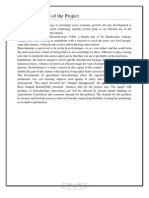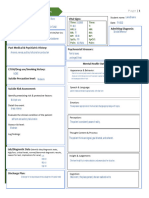Dairy Project (Amul)
Dairy Project (Amul)
Uploaded by
Akram Ul HoqueCopyright:
Available Formats
Dairy Project (Amul)
Dairy Project (Amul)
Uploaded by
Akram Ul HoqueOriginal Description:
Original Title
Copyright
Available Formats
Share this document
Did you find this document useful?
Is this content inappropriate?
Copyright:
Available Formats
Dairy Project (Amul)
Dairy Project (Amul)
Uploaded by
Akram Ul HoqueCopyright:
Available Formats
Amul
Group no.2
2011
Members- Ranjan, Piyush, Akram, Bharath, Somojit Auddy
Introduction
India is the largest producer of milk in the world and accounts 21% of the worlds production. India is with highest livestock populations in the world, it accounts 50% of the buffaloes and 20% of the worlds cattle population, most of which are milch cows and milch buffaloes. Indias dairy industry is considered as one of the most successful development industry in the postIndependence era. In 2005-06 total milk productions in the country was over 90 million tonnes with a per capita availability of 229 gms per day. During 1993-2005, the dairy industry recorded an annual growth of 4%, which is almost 3 times the average growth rate of the dairy industry in the world. The total milk processing in India is around 35%, of which the organized dairy industry accounts for 13% while remaining is either consumed at farm level, or sold as fresh, non-pasteurized milk through unorganized channels. The milk surplus states in India are Uttar Pradesh, Punjab, Haryana, Rajasthan, Gujarat, Maharashtra, Andhra Pradesh, Karnataka and Tamil Nadu. The manufacturing of milk products is very much concentrated in these states due to the availability of milk in huge quantity. According to the Ministry of Food Processing Industries, exports of dairy products have been growing at the rate of 25% per annum in terms of quantity and 28% in terms of value since 2001. Significant investment opportunities exist for the manufacturing of value-added milk products like milk powder, packaged milk, butter, ghee, cheese and ready-to-drink milk products.
Rationale of choosing the industry
Dairying is an important source of subsidiary income to small/marginal farmers and agricultural labourers other than agriculture. The manure from animals provides a good source of organic matter for improving soil fertility and crop yields. The main aim of the Indian dairy industry is only to better manage the national resources to enhance milk production and upgrade milk processing using innovative technologies. Since agriculture is mostly seasonal, there is a
KIIT SCHOOL OF RURAL MANAGEMENT
Page 1
Amul
2011
possibility of finding employment throughout the year for many persons through dairy farming. Thus, dairy also provides employment throughout the year. The main beneficiaries of dairy programmes are small/marginal farmers and landless laborers.
Size of Indian Dairy Industry
Dairy India 2007 has estimated the size of Indias dairy sector in 2005 at Rs 227,340 crore (valued at consumer prices). The largest contributor to this is liquid milk (at Rs 82,835 crore), followed by ghee (Rs 22,980 crore), khoa/chhana/paneer (Rs 24,100 crore), milk powder (Rs 4,680 crore), table butter (Rs 770 crore), cheese/edible casein (Rs 975 crore) and other products such ethnic sweets, ice-cream, etc (Rs 9,100 crore). Out of the total milk production of 94.5 mt, 77 per cent or 73.1 mt is sold as liquid milk, with the balance 23 per cent or 21.4 mt converted into products. Further, the organized industry handles only 18 per cent or 17 mt of milk, with 36 per cent (34.5 mt) being handled by private dudhias and unorganized players and 46 per cent (43 mt)being retained in rural areas. Within the 18 per cent organized sector share, private and cooperative/government dairies handle an equal 8.5 mt each.
Growth Potential (Market)
The total milk production in the country for the year 2008-09 was estimated at 108.5 million metric tonnes and the demand is expected to be 180 million tonnes by 2020. To achieve this demand annual growth rate in milk production has to be increased from the present 2.5 % to 5%. Thus, there is a tremendous scope/potential for increasing the milk production through profitable dairy farming.
Importance of Dairy Farm in economy
By 2011, Dairy India projects the value of the industry to more than double to Rs 520,780 crore, which includes Rs 159,600 crore from liquid milk, Rs 42,680 crore from ghee, Rs 50,500 crore from khoa/chhana/paneer, Rs 9,100 crore from milk powder, Rs 2,250 crore from table butter, Rs 6,150 crore from cheese/edible casein and Rs 25,050 crore from other products. Interestingly, out of the anticipated milk output of 120 mt, the share of liquid milk will rise to 81 per cent or 97.5 mt and only the rest 19 per cent (22.5 mt) would get converted into products. But the
KIIT SCHOOL OF RURAL MANAGEMENT
Page 2
Amul
2011
organized industrys share of total milk handling will go up to 30 per cent (36 mt), while the small players will see their share dip to 22 per cent (26 mt). At the same time, higher rural incomes will marginally boost the share of milk retained in rural areas to 48 per cent or 58 mt. The other significant feature is that within the 30 per cent overall share of organized dairies, the major 20 per cent (24 mt) will be accounted for by the private sector. The cooperatives and government dairies will handle 10 per cent or 12 mt of milk, which will be lower than that of the organized private sector.
Competitors in Dairy Industry: -
Private competitors and small dairy cooperatives (In an organized dairy industry, dairy cooperatives account for the major share of processed liquid milk marketed in India. Milk is processed and marketed by 170 Milk Producers Cooperative Unions, which federate into 15 State Cooperative Milk Marketing Federations. Over the years, several brands have been created by cooperatives like Amul (GCMMF), Vijaya (AP), Verka (Punjab), Saras (Rajasthan). Nandini (Karnataka), Milma (Kerala) and Gokul (Kolhapur).
Organization Description
Name of Organization- GCMMF(Amul)
Description- Amul ("priceless" in Hindi. The brand name "Amul," from the Sanskrit "Amoolya," (meaning Precious) was suggested by a quality control expert in Anand.), formed in 1946, is a dairy cooperative in India. It is a brand name managed by an apex cooperative organisation, Gujarat Co-operative Milk Marketing Federation Ltd. (GCMMF), which today is jointly owned by some 2.8 million milk producers in Gujarat, India. Amul is based in Anand, Gujarat and has been an example of a co-operative organization's success in the long term. "Anyone who has seen the dairy cooperatives in the state of Gujarat, especially the highly successful one known as AMUL, will naturally wonder what combination of influences and incentives is needed to multiply such a model a thousand times over in developing regions everywhere." The Amul Pattern has established itself as a uniquely appropriate model for rural development. Amul has spurred the White Revolution of India, which has made India the largest producer of milk and milk products in the world. It is also the world's biggest vegetarian cheese brand. Amul is the
KIIT SCHOOL OF RURAL MANAGEMENT
Page 3
Amul
2011
largest food brand in India and world's Largest Pouched Milk Brand with an annual turnover of US $1700 million (200910).[5] Currently Unions making up GCMMF have 2.9 million producer members with milk collection average of 9.10 million litres per day. Besides India, Amul has entered overseas markets such as Mauritius, UAE, USA, Bangladesh, Australia, China, Singapore, Hong Kong and a few South African countries. Its bid to enter Japanese market in 1994 did not succeed, but now it has fresh plans entering the Japanese markets
Methodology
Primary Data Collection Survey through structured questionnaire Formal and informal interview
Collection of Secondary Data Profile of dairy companies Market analysis through websites
Outline of the Report
Chater 1- Introduction Chapter 2- Methodology Chapter 3- Analysis of Data and Key Findings Chapter 4- Inference Chapter 5- Recommendations
KIIT SCHOOL OF RURAL MANAGEMENT
Page 4
You might also like
- Amul StrategyDocument18 pagesAmul StrategyAkram Ul Hoque100% (12)
- Summer Internship Project Marketing Strategy of Mother DairyDocument41 pagesSummer Internship Project Marketing Strategy of Mother DairyPREETI GUPTANo ratings yet
- Summer Internship Project Marketing Strategy of Mother DairyDocument41 pagesSummer Internship Project Marketing Strategy of Mother DairyPREETI GUPTANo ratings yet
- Summer Internship Project - Marketing Strategy of Mother DairyDocument47 pagesSummer Internship Project - Marketing Strategy of Mother DairyPrashant Bisht67% (3)
- Dairy Cooperatives in IndiaDocument13 pagesDairy Cooperatives in IndiaShafqat ShaikhNo ratings yet
- Amul MilkDocument81 pagesAmul MilkRavi SharmaNo ratings yet
- Dairy IndustryDocument17 pagesDairy IndustryAarti GajulNo ratings yet
- Part of Amul ProjectDocument8 pagesPart of Amul ProjectSunil PrajapatNo ratings yet
- Amul WordDocument8 pagesAmul WordPawan MamaniyaNo ratings yet
- Tejas Govind DessertationDocument42 pagesTejas Govind DessertationKajal PundNo ratings yet
- Dairy Industry in India - An IntroDocument2 pagesDairy Industry in India - An IntroArun D. Naik-TamannavarNo ratings yet
- New Microsoft Office Word DocumentDocument3 pagesNew Microsoft Office Word DocumentDharmik MalaviyaNo ratings yet
- Distribution Channel Management AmulDocument41 pagesDistribution Channel Management AmulGaganpreetmultani9860% (5)
- LPT Milk and Milk Products: Sanjay Kumar ApDocument111 pagesLPT Milk and Milk Products: Sanjay Kumar ApSanjay KumarNo ratings yet
- Vimal DairyDocument120 pagesVimal Dairyrushabhbholo83% (6)
- Strengths: India Being The Leading Producer of Milk Is Self-Sufficient in MilkDocument6 pagesStrengths: India Being The Leading Producer of Milk Is Self-Sufficient in MilkHarshavardhan ReddyNo ratings yet
- Aashima Pankaj Ritu Sushil Vidushi PartB WACII.2Document21 pagesAashima Pankaj Ritu Sushil Vidushi PartB WACII.2sameernagpur61No ratings yet
- Indian Dairy IndustryDocument7 pagesIndian Dairy IndustryRuchiNo ratings yet
- Industrial Report On Saras DairyDocument88 pagesIndustrial Report On Saras DairyDeepak ChelaniNo ratings yet
- The Dairy Industry AnalysisDocument11 pagesThe Dairy Industry AnalysisAaron Abraham100% (1)
- Indian Dairy IndustryDocument5 pagesIndian Dairy IndustryVenkati MuttappaNo ratings yet
- Dairy Industry in India Current Perspective and Status Biology EssayDocument9 pagesDairy Industry in India Current Perspective and Status Biology EssayKrishnakumar KNo ratings yet
- Final Project of AnkitaaaaDocument37 pagesFinal Project of Ankitaaaaankita nainNo ratings yet
- Dairy Project Report FullDocument5 pagesDairy Project Report FullRamakrishna Naidu67% (3)
- Milk IndustryDocument7 pagesMilk Industrydilip15043No ratings yet
- An Organisational Study at Milma Diary Farm Part 1Document15 pagesAn Organisational Study at Milma Diary Farm Part 1Aromal SSNo ratings yet
- Milk AdvertisementDocument27 pagesMilk AdvertisementShanib PtNo ratings yet
- Certificate: M.R Dinesh Kumar Singh (Hod)Document57 pagesCertificate: M.R Dinesh Kumar Singh (Hod)Deepika SinghNo ratings yet
- Amul (Milk and Tru) : 1. Macro-Environmental AnalysisDocument2 pagesAmul (Milk and Tru) : 1. Macro-Environmental AnalysisGandhi Jenny Rakeshkumar BD20029No ratings yet
- A.Introduction: Dairy Industries in India Is Traditional A Long Way From Dependence To Self-RelianceDocument2 pagesA.Introduction: Dairy Industries in India Is Traditional A Long Way From Dependence To Self-Relianceagjp_agrico51No ratings yet
- Sanket Project MPDocument51 pagesSanket Project MPSanket MaheshwariNo ratings yet
- Indian Dairy Industry (& Potential For Lactose Free Products)Document54 pagesIndian Dairy Industry (& Potential For Lactose Free Products)India Business ReportsNo ratings yet
- Mother DairyDocument20 pagesMother Dairyno nameNo ratings yet
- THESISDocument69 pagesTHESISChaithanya KumarNo ratings yet
- SwotDocument15 pagesSwotManali RedkarNo ratings yet
- Synopsis: Devi Ahilya Vishwavidyalaya, IndoreDocument15 pagesSynopsis: Devi Ahilya Vishwavidyalaya, IndoreankitanshuuNo ratings yet
- The Karmali Dudh Utpadak Shahkari Mandali LimitedDocument76 pagesThe Karmali Dudh Utpadak Shahkari Mandali LimitedSalim NoratNo ratings yet
- Customer Perception of MilkDocument22 pagesCustomer Perception of MilkShruti PapnejaNo ratings yet
- Amul Research PaperDocument4 pagesAmul Research PaperJoshua DevNo ratings yet
- AmulDocument7 pagesAmulabhayNo ratings yet
- Amul FMCGDocument9 pagesAmul FMCGKhwahish ChhablaniNo ratings yet
- Export Potential of Dairy ProductsDocument17 pagesExport Potential of Dairy ProductsVarun GulatiNo ratings yet
- ProjectDocument59 pagesProjectSanthosh SomaNo ratings yet
- Milk Production in India: National Dairy Development Board (NDDB)Document5 pagesMilk Production in India: National Dairy Development Board (NDDB)midhun016No ratings yet
- An Overview of Dairy Processing Industry and Its Important Role in The Country'S Socio-Economic DevelopmentDocument4 pagesAn Overview of Dairy Processing Industry and Its Important Role in The Country'S Socio-Economic DevelopmentNAVYASHREE B 1NC21BA050No ratings yet
- Amul AnalysisDocument21 pagesAmul AnalysisHarshavardhan ReddyNo ratings yet
- Dairy IndustryDocument20 pagesDairy IndustryMEGHANA SNo ratings yet
- Chapter IiDocument14 pagesChapter IiRevathy Saju Thyagarajan100% (1)
- Problems N OpportunitiesDocument4 pagesProblems N OpportunitiesChirag ShahNo ratings yet
- Sales and Distribution Management of AmulDocument24 pagesSales and Distribution Management of AmulAnnanya VermaNo ratings yet
- Dairy Farming : Modern Approaches to Milk Production and ProcessingFrom EverandDairy Farming : Modern Approaches to Milk Production and ProcessingNo ratings yet
- Food Outlook: Biannual Report on Global Food Markets July 2018From EverandFood Outlook: Biannual Report on Global Food Markets July 2018No ratings yet
- Micro or Small Goat Entrepreneurship Development in IndiaFrom EverandMicro or Small Goat Entrepreneurship Development in IndiaNo ratings yet
- Food Outlook: Biannual Report on Global Food Markets. October 2016From EverandFood Outlook: Biannual Report on Global Food Markets. October 2016No ratings yet
- Augmentation of Productivity of Micro or Small Goat Entrepreneurship through Adaptation of Sustainable Practices and Advanced Marketing Management Strategies to Double the Farmer’s IncomeFrom EverandAugmentation of Productivity of Micro or Small Goat Entrepreneurship through Adaptation of Sustainable Practices and Advanced Marketing Management Strategies to Double the Farmer’s IncomeNo ratings yet
- Economic Opportunity Small Scale Dairy Farms at Keren Sub Zone of EritreaFrom EverandEconomic Opportunity Small Scale Dairy Farms at Keren Sub Zone of EritreaNo ratings yet
- Food Outlook: Biannual Report on Global Food Markets May 2019From EverandFood Outlook: Biannual Report on Global Food Markets May 2019No ratings yet
- Compendium on Micronutrient Fertilisers in India Crop Response & Impact, Recent Advances and Industry TrendsFrom EverandCompendium on Micronutrient Fertilisers in India Crop Response & Impact, Recent Advances and Industry TrendsNo ratings yet
- SUBWAY - Marketing PlanDocument22 pagesSUBWAY - Marketing PlanAkram Ul Hoque85% (40)
- Indusrial Analysis Arvind MillsDocument7 pagesIndusrial Analysis Arvind MillsAkram Ul Hoque100% (2)
- Akram MTS-1ReportDocument37 pagesAkram MTS-1ReportAkram Ul HoqueNo ratings yet
- Management Traineeship Segment - Ii: Host Organization:-"Gramin Vikas Trust"Document23 pagesManagement Traineeship Segment - Ii: Host Organization:-"Gramin Vikas Trust"Akram Ul HoqueNo ratings yet
- File Handout 2Document1 pageFile Handout 2Akram Ul HoqueNo ratings yet
- FreeCAD-0.15 Manual PDFDocument408 pagesFreeCAD-0.15 Manual PDFPere J FerrerNo ratings yet
- Dragon Age RPG, DLC - Creatures of Thedas - The WyvernDocument6 pagesDragon Age RPG, DLC - Creatures of Thedas - The WyvernOleksij Yemelin100% (2)
- 60 Mins Mains Electricity Exam Qs B+ With AnswersDocument20 pages60 Mins Mains Electricity Exam Qs B+ With AnswersmadhujayanNo ratings yet
- CRI G Flow Series Catalogue 50HzDocument18 pagesCRI G Flow Series Catalogue 50HzVENKATESH ANo ratings yet
- Analysis of A Welding AccidentDocument7 pagesAnalysis of A Welding AccidentMario SanchoNo ratings yet
- Ole Miss CVDocument4 pagesOle Miss CVapi-529746752No ratings yet
- LogiComm Sensors & Barcode Readers BrochureDocument4 pagesLogiComm Sensors & Barcode Readers BrochureNordson Adhesive Dispensing SystemsNo ratings yet
- Harmonic Sources - What Causes HarmonicsDocument11 pagesHarmonic Sources - What Causes HarmonicsMohammad HamamdNo ratings yet
- Leela Raviz Kovalam FactsheetDocument8 pagesLeela Raviz Kovalam FactsheetGM NGNo ratings yet
- RECONCILATIONDocument3 pagesRECONCILATIONchandra shekharNo ratings yet
- Ir PzwkpibpbekpDocument13 pagesIr PzwkpibpbekpSwarnab GhoshNo ratings yet
- Python RoadmapDocument28 pagesPython RoadmapVkkk LolNo ratings yet
- Loyalty: A Customer's Perspective: TH THDocument9 pagesLoyalty: A Customer's Perspective: TH THEmaNo ratings yet
- High Temp Resin For Heat ResistanceDocument2 pagesHigh Temp Resin For Heat Resistancelion100_saadNo ratings yet
- Precision Heart Rate TrainingDocument228 pagesPrecision Heart Rate TrainingTc Gklp71% (7)
- International Journal of Business, Social Sciences & EducationDocument23 pagesInternational Journal of Business, Social Sciences & EducationVino FayruzNo ratings yet
- Chapter Glossary: Properties of Pure SubstancesDocument6 pagesChapter Glossary: Properties of Pure SubstancesyusufNo ratings yet
- Comparative Analysis of Site-to-Site Layer 2 Virtual Private NetworksDocument6 pagesComparative Analysis of Site-to-Site Layer 2 Virtual Private NetworksAhmed EJNo ratings yet
- Ross-Tech WikiDocument2 pagesRoss-Tech WikimnemonicsNo ratings yet
- Trinity Institute of Professional Studies Affiliated To Guru Gobind Singh Indraprastha UniversityDocument17 pagesTrinity Institute of Professional Studies Affiliated To Guru Gobind Singh Indraprastha Universityanon_941457122No ratings yet
- Domain Preserving and Strongly Converging Explicit Scheme For The Stochastic SIS Epidemic ModelDocument16 pagesDomain Preserving and Strongly Converging Explicit Scheme For The Stochastic SIS Epidemic ModelDaniel NogNo ratings yet
- Rule Book 2nd Printing Part 1 PDFDocument25 pagesRule Book 2nd Printing Part 1 PDFRenato BorghiniNo ratings yet
- Care Plan Worksheet Mental Health 2022Document3 pagesCare Plan Worksheet Mental Health 2022tahani.mah147No ratings yet
- Carter Common Failures in Gas Turbine BladesDocument11 pagesCarter Common Failures in Gas Turbine BladesLeire MeigaNo ratings yet
- English Coursework BibliographyDocument7 pagesEnglish Coursework Bibliographybcr1vtj5100% (2)
- Literature Review of Asteroidea Sea StarsDocument11 pagesLiterature Review of Asteroidea Sea StarsSett SambajonNo ratings yet
- Grate KilnDocument8 pagesGrate KilnAnggiet HerdayantiNo ratings yet
- WEB Jungle King BrochureDocument2 pagesWEB Jungle King BrochurePeter RodriguezNo ratings yet
- CARPENTRY Interpret Drawings and PlansDocument67 pagesCARPENTRY Interpret Drawings and PlansVergil MontemayorNo ratings yet
- Its Importance: MarketingDocument20 pagesIts Importance: MarketingAbdullah JavedNo ratings yet






























































































